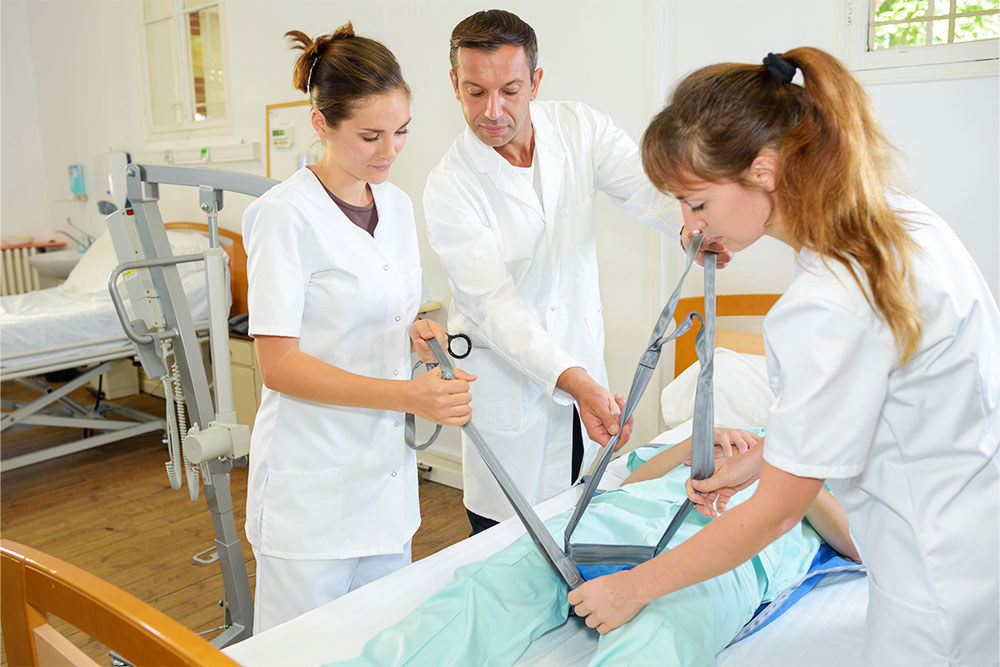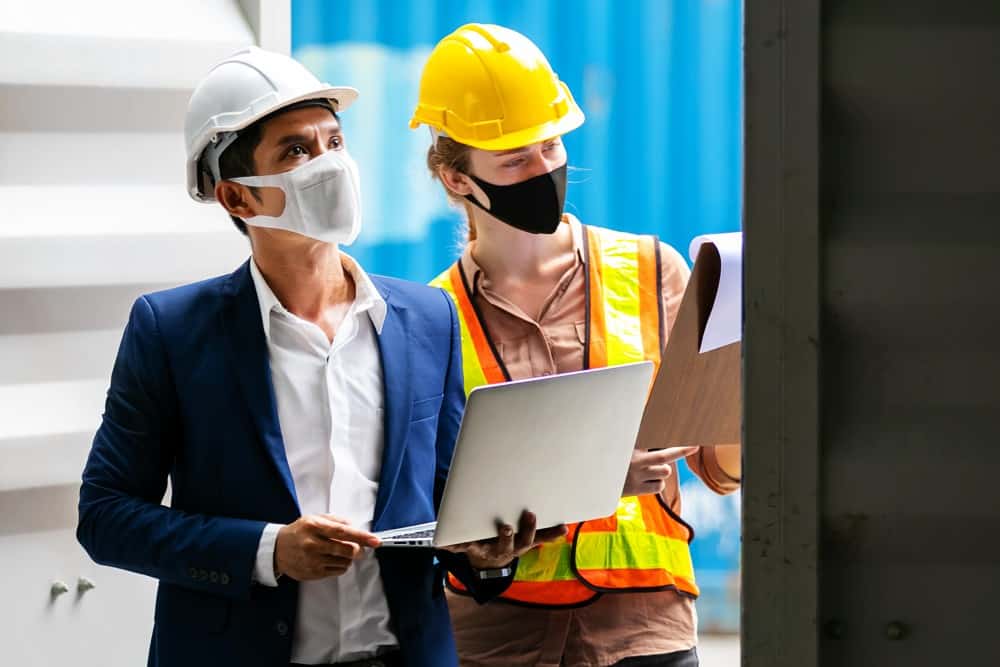
Moving and handling people is a regular task in health and social care. It’s also a leading cause of work-related injury if not done correctly.
This guide goes over moving and handling legislation you must comply with when assisting service users. It will help you ensure moves are effective, respectful and safe for everyone involved.
Key Takeaways
- Moving and handling people can be risky for both staff and service users, which is why it’s essential to comply with multiple regulations.
- Employers must carry out generic risk assessments and individual risk assessments to ensure that moves are safe and effective.
- Lifting equipment must meet legal standards for safety, suitability and maintenance.
- Proper training for staff is crucial to managing risks, and all risk assessments should be regularly reviewed and updated.
- Although not legally required, a moving and handling policy helps ensure compliance with moving and handling legislation.
What is Moving and Handling People?
This guide covers moving and handling – a type of manual handling that involves helping people move around safely and respectfully. It includes:
- Lifting
- Carrying
- Helping people move positions
- Helping people walk
- Helping people dress
- Vehicle transfers
Whenever an employee has to help a service user move, both parties are at risk. Employees might be injured because of the physical strain involved, while service users might fall or be hurt if unsafe techniques are used. Improper moving and handling also risks upsetting or embarrassing the person being assisted.
Moving and Handling Legislation
There’s no single piece of legislation that covers the moving and handling of people. Instead, employers (and employees) must comply with several statutory instruments when assisting service users. These are:
- The Health and Safety at Work etc. Act 1974
- The Management of Health and Safety Regulations 1999
- The Manual Handling Operations Regulations 1992
Moves that involve lifting equipment must also comply with:
- The Provision and Use of Work Equipment Regulations 1998
- The Lifting Operations and Lifting Equipment Regulations 1998
Complying with such a long list of manual handling legislation might seem intimidating, but in practice, it’s relatively straightforward. The most important step is carrying out risk assessments for moving and handling tasks.
With that said, each piece of legislation sets out different duties for you and your staff to meet. We’ve gone over each of these below.
Health and Safety at Work Act 1974
The Health and Safety at Work Act 1974 (HSWA) is relevant whenever there’s a risk of work-related injuries.
Under the HSWA, workplaces must be made as safe as “reasonably practicable.” This wording acknowledges the impracticality of creating an utterly risk-free workplace while still placing duties on employers (and employees) to take steps to prevent accidents.
The necessary steps are outlined in the secondary legislation passed in support of the HSWA, the most important of which is the Management of Health and Safety Regulations 1999.
Management of Health and Safety Regulations 1999
The Management of Health and Safety Regulations 1999 are also relevant whenever there’s a risk of work-related injuries.
Under these regulations, you must carry out a workplace risk assessment to identify hazards and plan how to eliminate or control them.
If moving and handling people is identified as a risk in your workplace, you must comply with specific manual handling regulations.
Manual Handling Operations Regulations 1992
The Manual Handling Operations Regulations 1992 (MHOR) apply whenever there is a risk of injury related to the physical handling of any load – a legal definition that includes people.
MHOR sets out what employers must do to manage manual handling risks in order:
- Eliminate the need to move loads by bodily force
- Assess the risks of any unavoidable manual handling tasks
- Implement risk controls and train staff to carry out manual handling safely
These principles also apply to moving and handling people. Wherever possible, work should be redesigned, or equipment should be used so employees don’t need to assist service users manually.
If elimination isn’t practical (either because of cost or effort), you must assess the risks of the task and implement control measures to protect workers and the people being lifted. One of these control measures must be appropriate training.
If your workers use equipment to reduce or eliminate injury risks during a lift, you must comply with additional regulations.
Equipment Regulations
All equipment used in the workplace, including equipment used to move service users, must comply with the Provision and Use of Work Equipment Regulations 1998 (PUWER).
Under PUWER, you must ensure equipment is suitable, safe and maintained in efficient working order. This last point requires regular equipment inspection and servicing by competent people.
You should also be aware of the Lifting Operations and Lifting Equipment Regulations 1998 (LOLER), which apply whenever a load (which can be a person) is lifted.
LOLER sets similar duties to PUWER regarding equipment (it must be suitable, safe and regularly serviced). It also requires lifting operations to be planned, carried out and supervised by competent personnel, which means workers need the proper knowledge, skills and training to move service users safely.

Risk Assessments
Moving and handling legislation revolves around risk assessment. You can’t fulfil your duty to ensure workers and people being moved are safe unless you’ve assessed and accounted for injury risks.
To do this, you’ll need to complete a generic risk assessment for your workplace and individual risk assessments for each service user who needs assistance.
Generic Risk Assessments
Generic risk assessments should cover your whole workplace and consider the typical:
- Type of moving and handling tasks happening
- How often moving and handling is necessary
- Staffing levels (including training and experience)
- Workplace (is it easy to manoeuvre around, how far do service users need to travel when being moved, etc.)
- Equipment needed
- Emergency moving and handling needs (which service users would need help evacuating)
This assessment should give you a good understanding of injury risks and necessary control measures. For example, are staff broadly undertrained? Or could certain equipment be brought to service users to eliminate the need for moving people?
From here, you should move on to individual risk assessments.
Individual Risk Assessments
Individual risk assessments should be completed for each service user who needs assistance moving.
The assessment must include:
- What the service user can/can’t do without help
- Individual factors that make an injury more likely to happen, such as a tendency to fall or tire quickly
- Plans for different types of transfers
- Specific equipment needed and how it will be used
NHS Scotland provides an example individual risk assessment here.
Individual risk assessments are mainly used for safety and should outline how workers can protect themselves and the service user during all moves. Safety isn’t the only concern, however.
Service users must be moved respectfully and with the minimum level of intervention necessary to prevent injuries. So, individual risk assessments should reflect the service user’s needs and preferences and, where possible, the family’s wishes.
Monitoring and Review
Risk assessments are not static documents. It’s best practice to schedule regular reviews to ensure all risks are accounted for and control measures are working. It’s also necessary to revisit individual risk assessments if a service user’s circumstances change.
You should also monitor moving and handling activities to check that the correct techniques and equipment are being used.
Moving and Handling Policies
A moving and handling policy isn’t required by law but will help you comply with moving and handling legislation.
It should set out key roles and responsibilities, with details on:
- Your commitment to safe and respectful moving and handling
- Risk assessment procedures and reviews
- Staff procedures for reporting concerns and accidents
- Staff training records
- Equipment arrangements, including maintenance
- How you’ll monitor moving and handling activities
Moving and Handling People Training
With so many regulations to follow, staying compliant with moving and handling legislation can seem tricky. But the right training ties it all together.
Our online Moving and Handling of People Training gives your team the skills and knowledge to handle moves safely and compliantly. It provides comprehensive guidance for moving patients and service users and ensures that health and social care workers understand how to make all moves respectful, dignified and safe for everyone involved.
About the author(s)

Jonathan Goby




























































































































































































































































































































































































































































































































































































































































